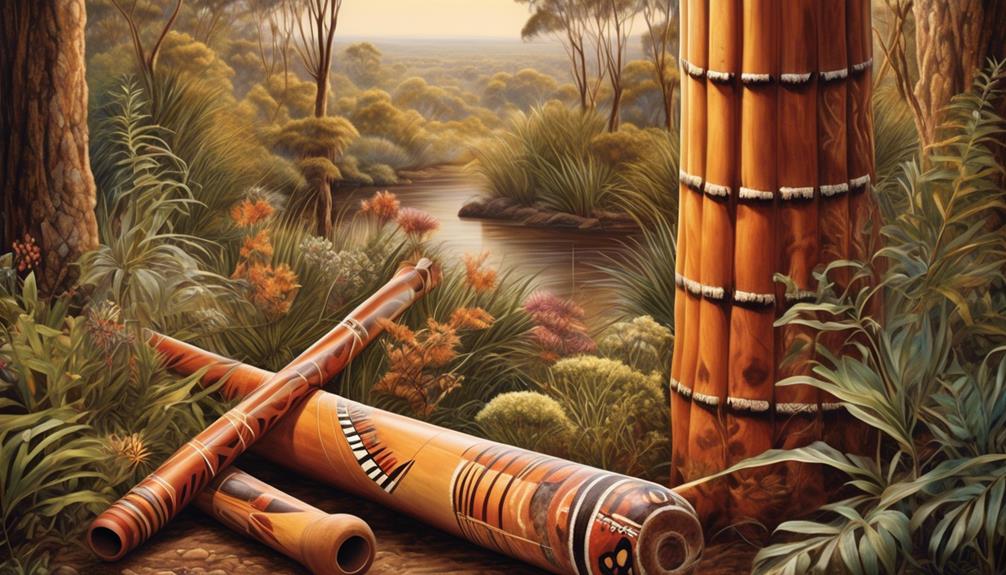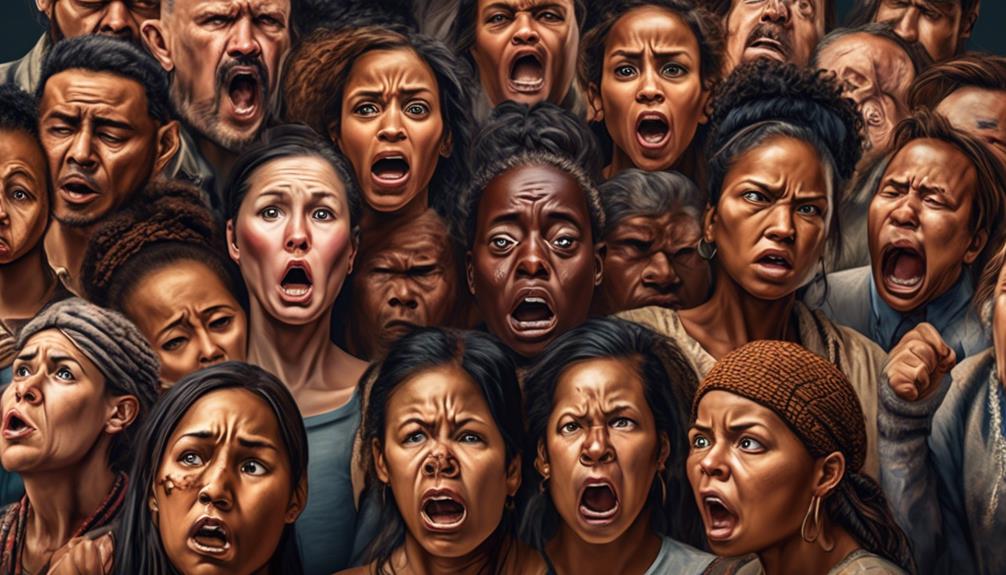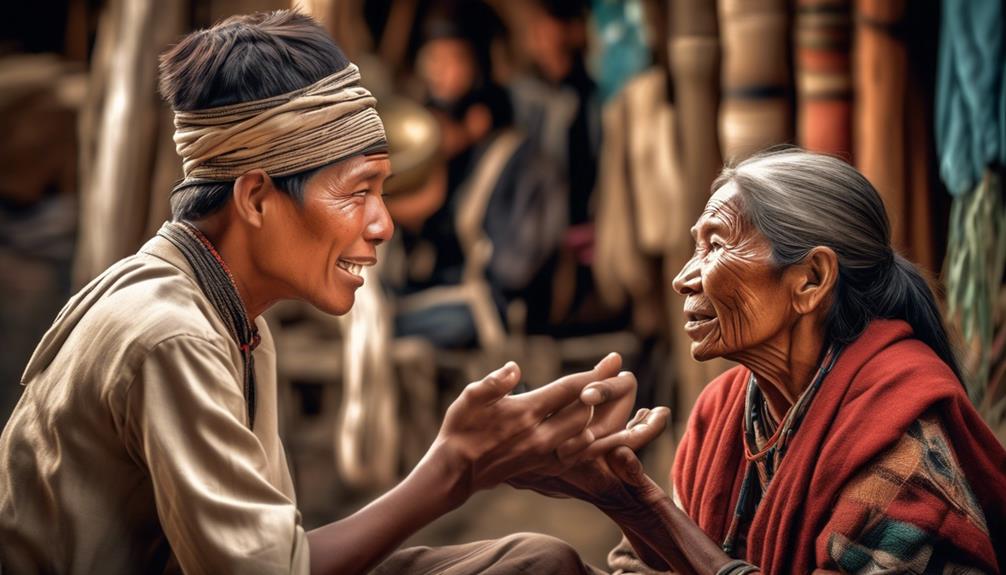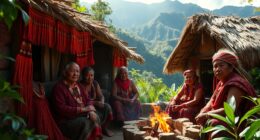Did you know that Aboriginal Australians have a rich history of creating and playing musical instruments that spans over 40,000 years? Many people are unaware of the diverse musical traditions that exist within this community.
The types of instruments they used are as varied as their culture and traditions, ranging from traditional wind instruments and percussion instruments to stringed and ceremonial instruments.
However, the intriguing part is the way these instruments were used in their traditional and contemporary contexts, which sheds light on the deep cultural significance of music in their society.
Key Takeaways
- Aboriginal Australians have a rich musical heritage dating back over 40,000 years.
- Traditional wind instruments like the didgeridoo hold cultural significance and connect players and listeners to ancestral spirits.
- Percussion instruments, such as clapsticks and didgeridoos, are used to convey ancestral stories and sustain oral traditions.
- Stringed instruments reflect the diverse and intricate nature of Aboriginal Australian musical heritage, with each region having its distinct techniques and tunings.
Traditional Wind Instruments
Traditional wind instruments have played a vital role in the musical traditions of Aboriginal Australian cultures, serving as integral components of ceremonial and storytelling practices.
The didgeridoo, a traditional wind instrument, holds immense cultural significance for Aboriginal Australians. Its deep, resonant tones are believed to connect players and listeners to the ancestral spirits of the land, making it a powerful tool for storytelling and cultural preservation. The techniques used to play the didgeridoo are passed down through generations, with each community adding its unique style and embellishments, creating a diverse tapestry of sound across different regions. Circular breathing, a fundamental technique, allows for a continuous drone, symbolizing the eternal nature of the land and the spirits that inhabit it.
The cultural significance of the didgeridoo extends beyond its musical function. It's often intricately decorated with traditional motifs that hold spiritual meanings, reflecting the interconnectedness of music, art, and cultural identity.
As researchers, understanding these intricate details is crucial in preserving and respecting Aboriginal Australian musical traditions, ensuring that these rich cultural practices continue to thrive for generations to come.
Percussion Instruments
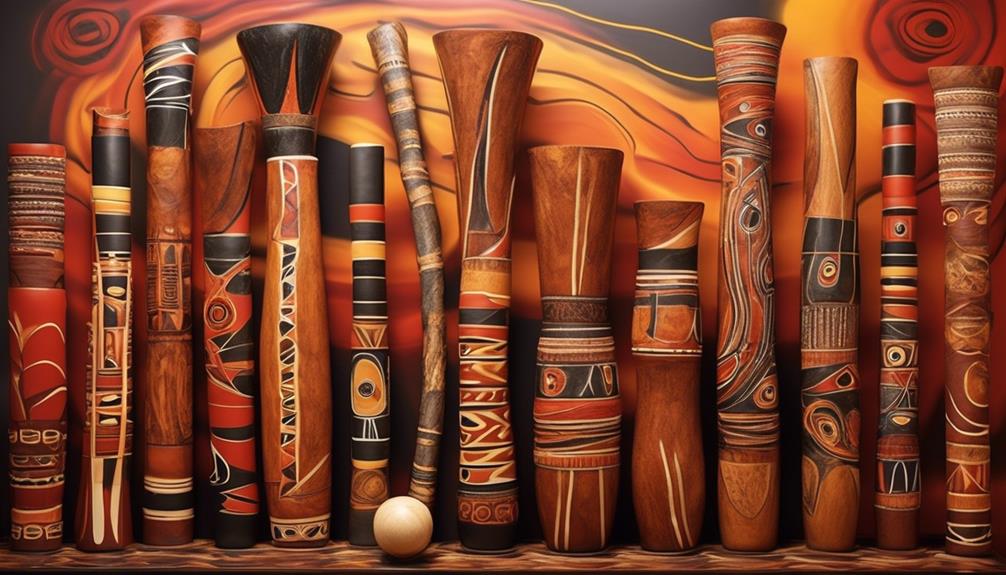
Percussion instruments in Aboriginal Australian cultures hold significant cultural and spiritual importance, serving as integral components of ceremonial rituals and storytelling traditions. The cultural significance of these instruments lies in their ability to convey ancestral stories, transmit knowledge, and connect individuals to their land and heritage through rhythmic patterns.
These instruments are often made from natural materials such as wood, animal hides, and seeds, reflecting the deep connection to the environment and the ancestral spirits. Playing techniques vary across different Aboriginal groups, with some using clapsticks to produce rhythmic beats, while others employ the didgeridoo as a percussive instrument by tapping and slapping its exterior.
The rhythmic patterns produced by these instruments not only accompany song and dance but also serve as a means of communication, conveying messages and emotions.
The use of percussion instruments in Aboriginal Australian cultures not only showcases musical creativity but also sustains the oral traditions and cultural practices, contributing to the preservation of indigenous heritage and identity.
Stringed Instruments
Stringed instruments play a significant role in the musical traditions of Aboriginal Australian cultures, reflecting the diverse and intricate nature of their musical heritage. The evolution of stringed instruments among Aboriginal Australians has been influenced by the natural resources available in their environment. Traditionally, these instruments were crafted using materials such as wood, animal tendons, and plant fibers, showcasing the resourcefulness and ingenuity of the indigenous communities.
The didgeridoo, although not a stringed instrument, is an integral part of Aboriginal Australian music and often accompanies stringed instruments in performances. In some instances, didgeridoo techniques are incorporated into the playing of stringed instruments, creating a unique and mesmerizing sound.
The stringed instruments of Aboriginal Australian cultures vary across different regions, each with its distinct techniques and tunings. These instruments aren't only used for entertainment but also hold cultural and spiritual significance. The melodies produced by these instruments often convey stories of the land, history, and ancestral knowledge, serving as a means of preserving and sharing the rich cultural heritage of the Aboriginal Australian people.
Ceremonial Instruments
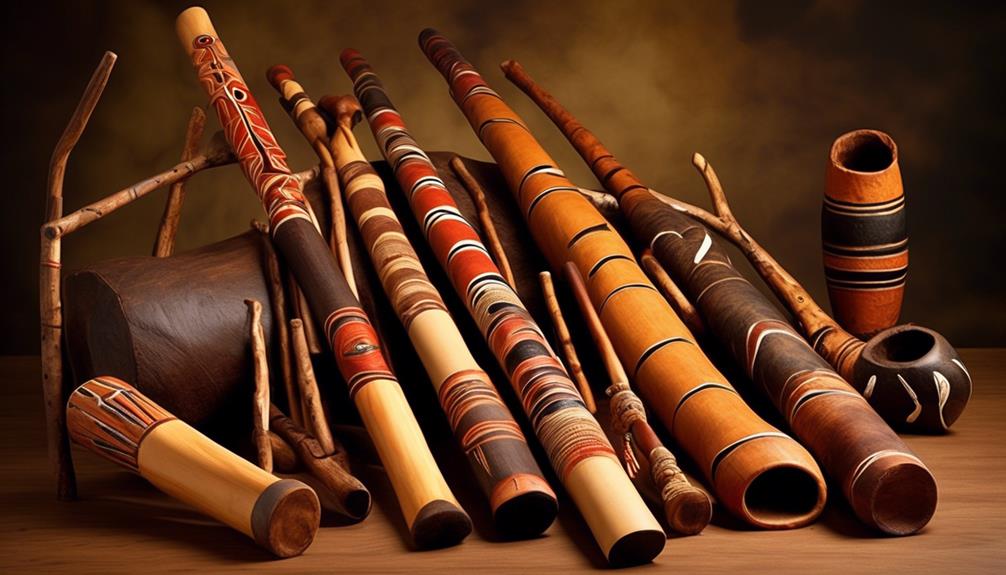
In the ceremonial context, Aboriginal Australian musical instruments play a pivotal role in conveying cultural significance and spiritual connections within indigenous communities. These instruments are deeply intertwined with the cultural fabric and heritage of Aboriginal Australian music, enriching ceremonial practices with their powerful resonance and symbolic meanings.
Two distinct categories of ceremonial instruments are prevalent:
- Percussion Instruments
- Didgeridoo: This iconic instrument, traditionally crafted from eucalyptus branches hollowed out by termites, holds profound spiritual significance. Its low, resonant tones are believed to connect the earthly realm with the ancestral spirits, serving as a conduit for storytelling and spiritual communication.
- Clapsticks: Used in ceremonial rituals, clapsticks produce rhythmic accompaniment, enhancing the ceremonial atmosphere. Their unique sounds contribute to the rhythmic heartbeat of the ceremonies, fostering a sense of unity and connection among participants.
- Wind Instruments
- Bullroarer: Utilized in initiation ceremonies, the bullroarer emits a haunting, whirring sound as it spins through the air. Its eerie tones are integral to invoking ancestral spirits and conveying cultural knowledge across generations. This instrument holds immense cultural significance, representing the interconnectedness of the spiritual and physical realms within Aboriginal Australian traditions.
Contemporary Adaptations
Contemporary adaptations of Aboriginal Australian musical instruments demonstrate the enduring cultural relevance and evolution of traditional musical practices within indigenous communities. Modern adaptations of these instruments serve as a testament to the resilience and cultural significance of Aboriginal Australian musical heritage. Through incorporating contemporary materials and techniques, these instruments continue to be utilized in both traditional ceremonies and modern artistic expressions.
| Traditional Instrument | Modern Adaptation |
|---|---|
| Didgeridoo | Electric Didgeridoo |
| Clapsticks | Electronic Drumsticks |
| Bullroarer | Digital Bullroarer |
| Gumleaf | Digital Gumleaf |
These modern adaptations allow for the preservation of cultural practices while also expanding the possibilities for creative expression. The incorporation of electronic elements into traditional instruments reflects the dynamic nature of indigenous musical traditions, adapting to the realities of modern life while maintaining their cultural significance. This evolution not only ensures the continuity of Aboriginal Australian musical heritage but also fosters innovation and experimentation within indigenous musical practices.
Frequently Asked Questions
How Did the Aboriginal Australians Learn to Play These Traditional Instruments?
We learned that the Aboriginal Australians traditionally passed down the art of playing instruments through a deep cultural significance. It was a central part of their heritage and connected them to their ancestors.
The learning process was deeply embedded in the historical context, with skill development occurring through observation, imitation, and storytelling. This method ensured the preservation of their musical traditions and allowed for the transmission of knowledge from one generation to the next.
Are There Any Specific Rituals or Ceremonies Associated With Playing These Ceremonial Instruments?
Specific rituals and ceremonies are integral to playing ceremonial instruments, reflecting their cultural significance and spiritual connection. These practices have been passed down through generations, contributing to historical preservation and shaping modern interpretations.
The significance of these rituals goes beyond the music itself, encompassing community bonds and storytelling. Understanding these traditions is crucial for respecting and appreciating the depth of Aboriginal Australian culture.
What Materials Were Commonly Used to Make These Instruments?
In crafting traditional Aboriginal Australian instruments, materials such as wood, bone, and animal hide were commonly used. These materials were carefully selected and shaped using intricate construction techniques to produce instruments with unique sounds and resonances.
The construction techniques employed were akin to an ancient art form, passed down through generations, ensuring that each instrument was a testament to the rich cultural heritage of the Aboriginal Australians.
How Have Contemporary Adaptations of These Traditional Instruments Changed the Sound or Function of the Original Instruments?
Contemporary adaptations of traditional Aboriginal Australian instruments have significantly changed the sound and function. These adaptations have been made to cater to modern audiences while still retaining the cultural significance and traditional techniques.
The modifications have allowed for the instruments to produce a wider range of sounds and be more versatile in various musical contexts. This has helped to keep the traditional instruments relevant and in use within both indigenous and non-indigenous communities.
Are There Any Specific Songs or Melodies That Are Traditionally Played on These Instruments?
Traditional melodies played on these instruments carry immense cultural significance, preserving the rich heritage of Aboriginal Australians. These songs often convey stories of creation, survival, and spiritual journeys.
Their melodies are deeply rooted in the land and its history, serving as a powerful connection to the past.
The preservation and continuation of these traditional melodies are vital for maintaining the cultural identity and heritage of the Aboriginal people.
Conclusion
In conclusion, the traditional music of Aboriginal Australians utilized a variety of instruments including wind, percussion, and stringed instruments for ceremonial and cultural purposes. These instruments were integral to their cultural identity and were used to create music that reflected their deep connection to the land and their spiritual beliefs.
It's clear that 'music was in their blood,' playing a crucial role in their traditions and storytelling.
